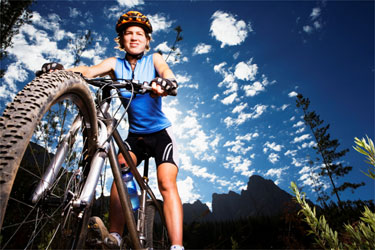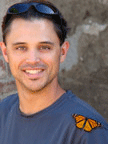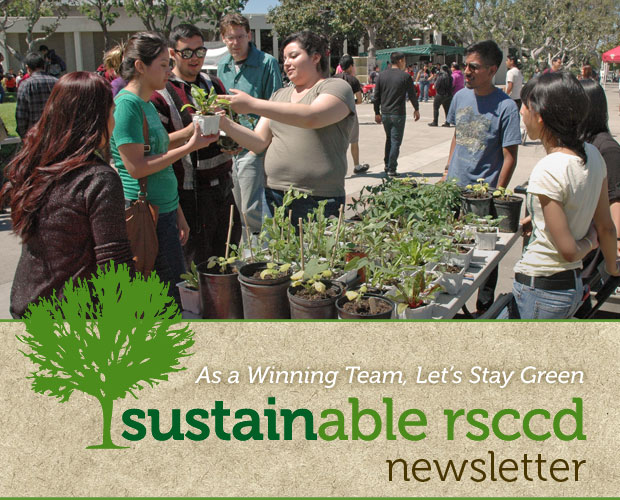Articles
SAC & SCC Host First
Earth Day Events
Celebrate Bike to Work Day
The Green Corner
Student Spotlight
Recommended Reading
|
Did You Know?
Founded in 1970, Earth Day was inspired by the antiwar protest of the late 1960s and was originally aimed at creating a global environmental movement.
Earth Day was held on April 22 as a "national teach-in on the environment" to maximize the number of students that could be reached on college and university campuses.
A highlight of the United Nations' Earth Day celebration in New York City is the ringing of the Peace Bell, a gift from Japan, at the exact moment of the spring equinox.
In 1969, Senator Gaylord Nelson, a Democrat from Wisconsin who is considered to be one of the leaders of the modern environmental movement, developed the idea for Earth Day.
Denis Hayes, the former student body president at Stanford University and then a graduate student at Harvard University, was selected as the first Earth Day's national coordinator.
On April 22, 1970, Earth Day rallies were held in Philadelphia, Chicago, Los Angeles, and most other American cities - 20 million people participated!
Today, Earth Day is observed in 192 countries, and coordinated by the nonprofit Earth Day Network, chaired by the first Earth Day 1970 organizer Denis Hayes.
LA/OC
Green Events
Get out & Be Green!
ORANGE COUNTY
Saturday, May 11, 2013
10 a.m. - 4 p.m.
Visit website
Tour beautiful and enchanting gardens located in Laguna Hills, San Juan Capistrano, Capistrano Beach and San Clemente. This is a truly rare opportunity to view these beautiful, published, private gardens up close. Visit their website to sign up for the tour.
Information:
(714) 731-9242
June 1, 2013
4 - 11 p.m.
Visit website
The festive event will include an environmental expo, entertainment, local art show, silent auction, guest speakers, live music and dancing. BBQ or vegetarian dinner can be purchased at the event.
Location:
Santiago Event Center
Silverado Canyon
View a complete list of farmer's markets throughout Orange County here.
LOS ANGELES
Saturday, May 11, 2013
10 a.m. - 4 p.m.
Visit website
Upcoming Wednesday Meetings
May 8, 15, 22 & 29
June 5 & 12
7:00-8:30 p.m.
Did you know it takes more than 2,400 gallons of water to produce a pound of beef? You save more water by not eating a pound of beef than by not showering for 6 months! Join a free Sustainable Works Green Living Workshop and learn how information like this will help you save money and positively impact your family, community, and ultimately the planet! Reduce your transportation impact and make more sustainable shopping and food choices.
Location:
Santa Monica Main Library
601 Santa Monica Blvd.
Santa Monica, CA 90401
The workshop is free.
Saturday, May 11
10 a.m.-5 p.m.
Visit website
The largest and most-respected green building and design expo in SoCal, AltBuild is for those committed to or curious about sustainable living through design, including general public and all design/building/architecture professionals. The expo features 40+ prominent speakers addressing sustainable and alternative building practices and 100+ exhibitors covering green building/water/energy issues.
Location:
Santa Monica Civic Auditorium
1855 Main St.
Santa Monica, CA 90401 |
|
Santa Ana and Santiago Canyon Colleges Host First Earth Day Events
On April 17, Santa Ana College (SAC) kicked off the Earth Day activities at RSCCD with Sustain-A-Palooza that focused on "moving towards sustainability." The day featured an Inter-Club Council Fest on the quad where clubs sold environmentally responsible goods to raise funds. The Collegiate Alliance for Positive Environmental Stewardship (CAPES) Club sold vegetable plants grown in the SAC greenhouse on top of Russell Hall and the Engineering Club built a bicycle that generated electric power to run a popcorn maker!
From the quad, the event moved indoors to The Spot where President Erlinda Martinez, Ed.D., welcomed some 150 students and Santa Ana Mayor Miguel Pulido. The mayor, who spoke about the green aspects of his administration, had the honor of drawing names of two lucky students who walked away with new bicycles donated by Janet's Bike Shop and Target. The South Coast Air Quality Management District (AQMD) presented the documentary, "The Right to Breathe." California environmental lawyer Tracy Egoscue spoke about water compliance issues and OC Food Access Coalition Executive Director Gillian Poe discussed sustainable food programs in Orange County.
The slogan for the Santiago Canyon College (SCC) Hawk Earth Fest on April 23 was "Be Green; Help Us Clean." As at SAC, a highlight of the day's activities included a display of alternate fuel vehicles, including a plug-in hybrid, an all-electric vehicle, and a hydrogen fuel cell car.
The SCC event was kicked off by Chancellor Raúl Rodríguez, Ph.D., and closed by remarks by President Juan Vázquez. The event included a presentation by South Coast AQMD and a water sustainability presentation. An exhibit of environmentally responsible organizations, products and practices, including Orange County Coastkeeper, the College Assistance Migrant Program (CAMP) promoting recycling, and others was featured.
[ Return to top ]

May 17 - Celebrate Bike to Work Day
Join RSCCD in celebrating Bike to Work Day on May 17th. Employees who participate will be entered to win prizes. If you don't have a bike, you can still participate by taking alternate transportation, running, walking, rollerblading, skateboarding to work. Last year, Americans participating in Bike to Work days kept 13 million pounds of greenhouse gases out of the atmosphere.
The Sustainable RSCCD Committee wants to hear from you. Participants in the RSCCD Bike to Work Day are encouraged to write a short paragraph about their experience and submit it. Winning entrees will be published in the next newsletter. Submit your paragraph and/or pictures to biketowork@rsccd.edu.
Give it a try ... maybe these facts will encourage you:
- The average annual cost to maintain a vehicle is
$3,000 - the average annual cost to maintain a bike is
$300 = that equals a savings of $2,700 per year.
- A 150-pound person can burn 500 calories per hour riding at a leisurely pace.
- By biking (running, walking, skateboarding) to work, you can reduce the number of greenhouse gases being released into the atmosphere by as much as 17,000 pounds per year.
But...
"I'm not in good enough shape to ride to work." - If you can walk a mile, you can easily ride five. The key is to bike at a comfortable pace. There's no rush, enjoy the ride.
"It takes too long." - Commutes of seven miles or less can actually be faster on a bike than driving based on the average commuter riding 10 mph.
"It's too far." - If you live further away, try driving to a mall or grocery store closer to work, then ride the rest of the way. Gradually park further and further away and before you know it, you'll be riding the whole way. If you live near a train station, the Metrolink now has bike cars, specifically for commuters. Take the train and then ride from the train station to work.
"We don't have a shower in the office." - If you ride at a leisurely pace, you'll stay cool and dry. Pick up the pace on the way home, for a workout. Pack some baby wipes and deodorant and you can freshen up in the restroom at work.
"It's not safe to ride on the street." - The odds of being involved in a car accident are double the odds of being injured or killed in a bicycling accident. The risk to your health is no greater on a bike than in a car.
Rules of the road
- Always wear a helmet! A helmet can mean walking away from a potential fatal crash.
- Be visible - wear brightly colored and reflective clothing; use lights (head light /tail light).
- Follow the rules of the road - ride on the right with the flow of traffic, signal turns, check your "blind spot," obey all traffic signals.
- Ride defensively - don't assume that someone sees you, make eye contact and be prepared to take evasive action. Always be aware of your surroundings, and on the lookout for potential hazards.
- Be predictable - avoid sudden stops and swerves. Some helpful hints
- Spin Smoothly - Choose a gear that allows you to spin the pedals comfortably without too much resistance ... lower gear, more revolutions per minute = easier on the legs.
- Gear Me - Use the gears to help you match your effort to the demands of the terrain, use lower gears going up hills and higher gears to go down. Shift before you need to. Effective use of the gears on a bike can make the ride easier and more fun.
- Pace Yourself - You might start off with a lot of energy but if you choose a fast pace in a high gear, you'll wear yourself out before you reach your destination. Pace yourself so you feel as good when you get to your destination as you did when you started the ride.
- Fuel Up - You are the engine on your bike. You would expect to get very far in a car with no gas, the same goes for your body. Remember to eat! Light meals that are easily digested and high in carbohydrates are great before a ride (e.g. cereal, toast, fruit). Proteins are best after the ride and will aid in restoring nutrients to your muscles.
- Water Wise - Remember to drink before you are thirsty. Your body loses water and dehydration can sneak up on you. Take a sip from your water bottle every 10 to 15 minutes at least. Use stop signs and traffic signals as a chance to hydrate.
- Packing Smart - Backpacks are great for transporting clothes, lunches, files, etc. to work. Try rolling clothes instead of folding them to minimize wrinkles.
Resources ... Check out these additional resources for more information, or visit a local bike shop
[ Return to top ]
The Green Corner
by Dr. Kimo Morris
In April 2013, members of our Rancho family celebrated Earth Day for the very first time! The events at SAC and SCC were filled with fun activities and riveting guest speakers and attendance by students, faculty and staff was well beyond our expectations! Clearly, our Rancho family was receptive to (and perhaps even eager for) this event, where the central theme is to recognize one's connection to the environment to which we are all inextricably linked.
 While it is important to rally support for sustainability today, it is always instructive to recall the developments that led to the very first Earth Day, on April 22, 1970. In the years leading up to that historic day, the environmental conditions near population centers were abysmal. While planet-level human impacts such as ozone depletion and global warming were largely unknown to the public at that time, citizens did begin to see and feel the consequences of a degraded environment - water contamination, depletion in air quality, damage to soil health, negative consequences of chemicals in the environment - the list goes on. While it is important to rally support for sustainability today, it is always instructive to recall the developments that led to the very first Earth Day, on April 22, 1970. In the years leading up to that historic day, the environmental conditions near population centers were abysmal. While planet-level human impacts such as ozone depletion and global warming were largely unknown to the public at that time, citizens did begin to see and feel the consequences of a degraded environment - water contamination, depletion in air quality, damage to soil health, negative consequences of chemicals in the environment - the list goes on.
But one event in particular provided the seed from which Earth Day would spring. On January 28, 1969, an unprecedented oil disaster unfolded off the coast of Santa Barbara, when the oil rig Platform "A" (then owned by Union Oil) had drilled into an oil deposit. After tapping into the oil, the drilling rig experienced a blowout, which led to a containment failure. For ten days, oil erupted from beneath Platform "A" releasing up to 100,000 barrels of oil, which killed thousands of birds, marine mammals, and fish, and fouled six miles of coastline.
The public outrage that ensued galvanized a nation around a common cause, and in the years that followed, the environment became center stage in political discussions from coast to coast. As a final push to urge lawmakers to take action, in April 1970, hundreds of simultaneous rallies were held across the United States, thus spawning the very first nationwide Earth Day event. Throughout the early 1970s, a number of key acts were signed into law including the Clean Water Act, the Clean Air Act, and the Endangered Species Act. These documents continue to serve as critical guidelines that oblige us to give value to the natural world.
And this is the bottom line - the natural world is probably the most valuable thing that we all collectively have. "Sustainability" really is about ensuring that natural resources are perpetuated from generation to generation, and that we take measures to enhance these resources rather than degrade them. This consideration is a focal point that guides and inspires us, and it is precisely why, 42 years later, we continue to celebrate Earth Day.
Greenly Yours,
Dr. Kimo Morris
Assistant Professor of Biology
Santa Ana College
[ Return to top ]
Student Spotlight:
Valerie Martinez, Santa Ana College (SAC) Associated Student Government Environmental Commissioner, holds environmental sustainability as a key value in her life. When the AQMD (Air Quality Management District) conducted a presentation for students and faculty of Santa Ana College last November, it became clear to her that it was time to put this value into action. With the support and guidance of SAC faculty, Valerie became part of the planning committee for an Earth Day Celebration which would come to be known as, Sustain-A-Palooza!
 The event was an opportunity to educate SAC students, staff, and faculty alike on various environmental issues including the effects of plastic bag and bottle use and alternative forms of transportation. Valerie feels that her generation understands the importance of environmental consciousness, but is lacking exposure and education to take appropriate action. She is grateful for courses like Biology 200 and is dedicated to spearheading efforts, like Sustain-A-Palooza, that will move this consciousness along. The event was an opportunity to educate SAC students, staff, and faculty alike on various environmental issues including the effects of plastic bag and bottle use and alternative forms of transportation. Valerie feels that her generation understands the importance of environmental consciousness, but is lacking exposure and education to take appropriate action. She is grateful for courses like Biology 200 and is dedicated to spearheading efforts, like Sustain-A-Palooza, that will move this consciousness along.
One way students can stay engaged with environmental issues is by joining the SAC Collegiate Alliance for Positive Environmental Stewardship (CAPES) Club, which meets every Thursday from 3-4 p.m. Information on the club's upcoming activities can be found on its Facebook page. Additionally, students can also be a part of the Associated Student Government and apply for the Environmental Commissioner position next year.
Please encourage students to become engaged in environmental sustainability issues! In our next issue, we will feature a student leader in sustainability from Santiago Canyon College.
[ Return to top ]
Recommended Reading
According to Go Green Street: Light Green Living Tips, you don't need to dramatically change your life to become eco-friendly, but rather, by making smart changes in your regular consumption, you can make enough of a difference in your life to leave a better carbon footprint and make your "green" changes count. With the recommended reading below, you can make it easier on yourself to actually implement sustainable efforts without a lot of money and planning.
TOP 5 Going Green Books
Get started going green with ease.
The Green Book: The Guide to Saving the Planet One Simple Step at a Time by Elizabeth Rogers
This book introduces you to one different change you can make in your home and lifestyle for every day of the year. All of them are easy enough to accomplish and there are even a couple more ambitious projects that you can consider once you get the basics covered.
It's Easy Being Green: A Handbook for Earth-Friendly Living
by Crissy Trask
Discover a wider variety of social changes that you can be a part of, both in and out of your home. This book is like a second step if you have already adopted most of the basic green principles in your home.
The Consumer's Guide to Effective Environmental Choices
by Michael Brower
Learn how to shop smart and shop with the environment in mind! Basics like vocabulary and the reasons behind some green principles are covered, as well as a directory to those businesses that embrace green principles.
Wake Up and Smell the Planet: The Non-Pompous, Non-Preachy Grist Guide to Greening Your Day by Grist Magazine
An off-the-wall guide to a lot of green practices that other books do not cover, and many that you might not ever consider until mentioned. Lots of new and interesting uses and reuses for everyday items.
The Lazy Environmentalist by Josh Dorfman
Get the extra motivation to get started on greening up your life! This guide offers little bits of green change that you can add to your life without having to even think twice about it.
[ Return to top ] |

